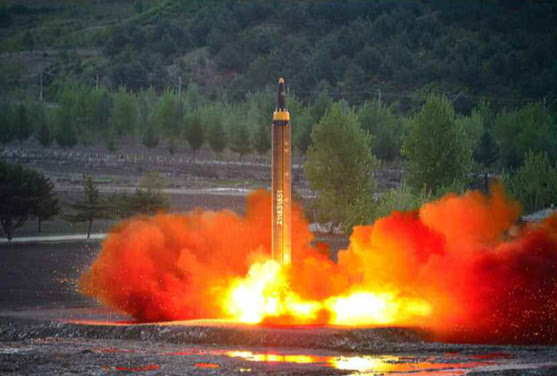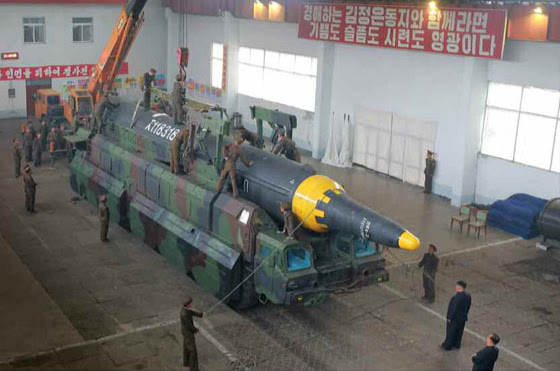North Korea’s New Hwasong-12 Missile

By now, we have at least learned the name of the new missile North Korea tested on May 14: the Hwasong-12. We also have photos of the launch, as we have come to expect from the North following a successful high-profile missile test. Those photos provide us with some information about this new missile but still leave us uncertain about key technical issues and particularly whether or not this test advanced North Korea’s worrying intercontinental ballistic missile (ICBM) program.
Could the Hwasong-12 engine be used in advancing development of an ICBM? One obvious feature of this new missile is the engine: a single nozzle with four verniers. This is not an ex-Soviet R-27 engine as is used on the Musudan, but neither is it the dual R-27 system they developed for the KN-08 missile and tested last year. While it is difficult to tell from the photos released, the Hwasong-12 engine looks very much like a new engine North Korea tested in March, which we assessed at that time as a probable space launch vehicle engine, in large part because there didn’t seem to be a missile appropriate for it. They may still use it in their next space launch vehicle, for which it would be quite appropriate, but it seems they are using at least a variant of it in this missile. The engine used on the HS-12 might not have quite enough thrust for an ICBM, but it was likely designed to demonstrate key technologies and components for a new ICBM engine. It won’t take long to modify this design for ICBM use, if that is North Korea’s goal.
What propellant powered the rocket? The propellant combination isn’t entirely clear either, as the North Koreans have been tinkering with the color balance on some of their photos for aesthetic effect. It is certainly a liquid propellant engine, and the most likely propellant candidates seem to be inhibited red fuming nitric acid (IRFNA) and unsymmetrical dimethylhydrazine (UDMH). This is slightly less efficient than the Musudan’s nitrogen tetroxide (NTO) and UDMH, but easier to store in the field. But we can’t rule out that the new engine uses the more efficient NTO/IRFNA, or even the old IRFNA/kerosene combination of the Nodong missile. Until we know exactly what propellant was used, we can’t make a more precise estimate of the engine’s performance.
Was this a single stage or two stage rocket? Less obvious but more curious is something we can’t see. There is no sign of a stage separation joint or mechanism on the Hwasong-12. This has led to suspicion that we are seeing a single-stage missile. However, the lack of a visible separation joint is not proof. North Korea’s traditional stage separation techniques would have been clearly visible even at the coarse resolution of the launch imagery, but there are more advanced designs where the system is largely internal and invisible. We had better imagery from the parade last month, which on examination also doesn’t show a visible joint, but parade missiles are almost always mock-ups and may not have all the detailed features of a real missile.
If this is a one-stage missile, it would be remarkable. The demonstrated performance, equivalent to a range of more than 4,500 km, may be unprecedented for a one-stage system. The only historic single-stage missile that might have matched the Hwasong-12’s performance is the old Soviet R-14 (aka SS-5), which with its lightest warhead could reach about 4,500 km—but that was an 80-ton behemoth, whereas the Hwasong-12 weighs perhaps only 20 tons. In order to deliver such performance from a package the size of a Hwasong-12, North Korea would have to couple an engine more efficient than any they have built before, with a structure far lighter than they have ever built before.
Even with these enhancements, the Hwasong-12 almost certainly could not have reached the reported 2,100 km apogee with anything more than an empty fairing where the reentry vehicle and warhead should be. Essentially, this would make the entire exercise a pointless stunt—they don’t have a missile until they test the reentry vehicle, and they won’t be fooling the allied intelligence agencies that have detailed radar tracking of the acceleration profile. More likely this was a two-stage missile with a heavy payload and a new stage separation mechanism.

Does this test advance North Korea’s ICBM program? A new engine, a new structural design and maybe a new stage separation mechanism is a lot of work for a missile that can target nothing farther than Guam. Make no mistake, Guam is an important target, but it’s not “design-a-new-missile-from-scratch” important. North Korea is likely going to use the technologies demonstrated here in its ongoing ICBM development program.
The new engine would be helpful. The dual R-27 engine system offered adequate performance for an ICBM, but barely so, and it was always going to have reliability problems in service. The new engine may offer better performance, and will almost certainly offer greater reliability. It also seems to be an engine North Korea can manufacture for itself, where they may have been drawing from a limited stockpile of surplus Soviet hardware for the R-27.
A new stage separation mechanism will make little difference unless it came as part of an improved structural technology, which could improve the performance of North Korea’s KN-08 and KN-14 ICBMs. Alternately, it could be used to make the missiles more rugged and readily transportable while keeping performance constant.
These advantages may mean two steps forward and one step backward for the ICBM program. They come with a cost: the missile will have to be substantially redesigned to use the new technologies. That means throwing out years of effort already put into the old design. And it means waiting until the Hwasong-12 has finished testing, before going forward with the final design of the ICBMs. We may have to concern ourselves with a more robust and capable ICBM system, but we shouldn’t be too concerned about it entering service next year. While the success of the Hwasong-12 may advance the North Korean ICBM program by perhaps a year, deployment of an operational ICBM prior to 2020 is still unlikely.
